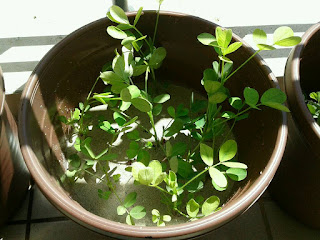Group Members:
| BS16110380 | NORSYAHIDATUL FITRI BINTI SABLIE (Captain) |
| BS16110526 | CHAN ZHENG YI |
| BS16110456 | ONG LI CHING |
| BS16110043 | GLENDA RYANNE FREDY |
| BS16110507 | MOHD HASNAWIE BIN HASSAN |
| BS16110371 | SITI NORWAFIQAH BINTI OMAR |
2nd Week Report PEANUT (CLICK HERE)
3rd Week Report PEANUT (CLICK HERE)
Overall Summary Report PEANUT (overall summary report)
MATERIAL PREPARATIONS:
(1) 5 recycle plastic pots that can fit in about 5 litres of soil.
~ Make holes for drainage at the pot bottom.
(2) The team need to collect four type of soil (6 litres each).
~ Collect different type of soil texture such as clay, silt, loam and sandy.
~ 1 type of soil will be provided from Mengkabong Lagoon.
~ Collect different type of soil texture such as clay, silt, loam and sandy.
~ 1 type of soil will be provided from Mengkabong Lagoon.
(3) Conduct soil pH test and soil texture triangulation for soil texture type for the report.
~ Dry at least 500 gram of each of the soil.
~ Before air dry outside the lab, take the wet soil weight measurement for each soil.
~ Measure the dry soil weight after completely dried. Then keep dry for further analysis (nutrient and heavy metal).
(4) Give the same amount of water for each watering session(tap water). Once a day. Example 500ml water for each pot.
Regularity of watering as follow:
Everyday on the first week.
Alternate days on the 2nd week.
Twice a week during 3rd week.
Once only on the 4th week.
~ Before air dry outside the lab, take the wet soil weight measurement for each soil.
~ Measure the dry soil weight after completely dried. Then keep dry for further analysis (nutrient and heavy metal).
(4) Give the same amount of water for each watering session(tap water). Once a day. Example 500ml water for each pot.
Regularity of watering as follow:
Everyday on the first week.
Alternate days on the 2nd week.
Twice a week during 3rd week.
Once only on the 4th week.
(5) Ruler/measurement tape
~ to record the growth of the plant.
PROCEDURE:
(1) Air dry some of soil samples (about 500gram) for heavy metal and macronutrient analysis.
~ Before soil are dried outside of the lab, take the measurement of wet soil weight.
~ The week after if the soil is totally dried up, take the measurement of dry soil weight.
~ Keep soil dry until further analyse.
(2) Measure the empty pot. Keep record.
(2) Measure the empty pot. Keep record.
(2) Fill up the pot with soil and cover the seed with soil (3cm deep). Measure the weight of the soil and pot. Keep record.
~ After 3rd week measure each pot and soil each time before you water your plant, so you can estimate the loss rate of water from different type of soil (Create a research question from this and observation data interpretation from this).
~ After 3rd week measure each pot and soil each time before you water your plant, so you can estimate the loss rate of water from different type of soil (Create a research question from this and observation data interpretation from this).
(3) For 1 pot sow 10 seeds each and space them apart from each other, so you can dig out several whole plants at 2 weeks old carefully out from the soil without disturbing other seedlings.
(4) After two weeks dig out 3 whole plant from each pot including the root carefully. Measure the length of the whole plant from root to shoot, root length and shoot length. Weigh the weight of the whole plant clean without soil, plant wet weight (fresh harvested state) and after plant in dried state (plant dry weight).Keep record.
Repeat for a month old plant.
(5) Count the number of nodules form at 2 weeks old and month old seedlings. Compare between different soil texture.
(6) Analyse the nutrient content of the soil.
Repeat for a month old plant.
(5) Count the number of nodules form at 2 weeks old and month old seedlings. Compare between different soil texture.
(6) Analyse the nutrient content of the soil.
OBSERVATION RECORD:
(1) Germination rate for each pot.
(2) How long does seeds start to sprout an emerge from the soil for each pot.
(3) Mortality/Survival rate of the plant growth.
(4) Growth of the plant of each plant for every week.
(5) Any deficiency symptoms such as yellowing of the leaves.
(6) Nutrient availability amount in sample soils.(7) Moisture content.
(8) Length of whole plant, root and shoot part separately at 2 weeks and a month old. Wet weight and Dry weight of whole plant without any soil attach.
(9) Number of nodules form at 2 weeks old and month old seedlings.
(10) Are there any heavy metal contamination in the soil samples.
RESEARCH QUESTIONS:
(1) Among five type of soils which is fertile for growing peanut.
(2) How does water content of each soil affect peanut growth.
(3) How does different soil texture affect the peanut growth.
(4) Nutrient availability for peanut from different soil texture.
(5) How does soil texture effect peanut root growth.
(6) How does water and soil texture affect number of nodules form on peanut root.
Read up on nitrogen-fixing plant.
Learn tips on how to grow peanut well.
Get to know peanut plant.
Don't forget to keep your reference list for your report.
Fill free to add on research questions or observation data.







No comments:
Post a Comment